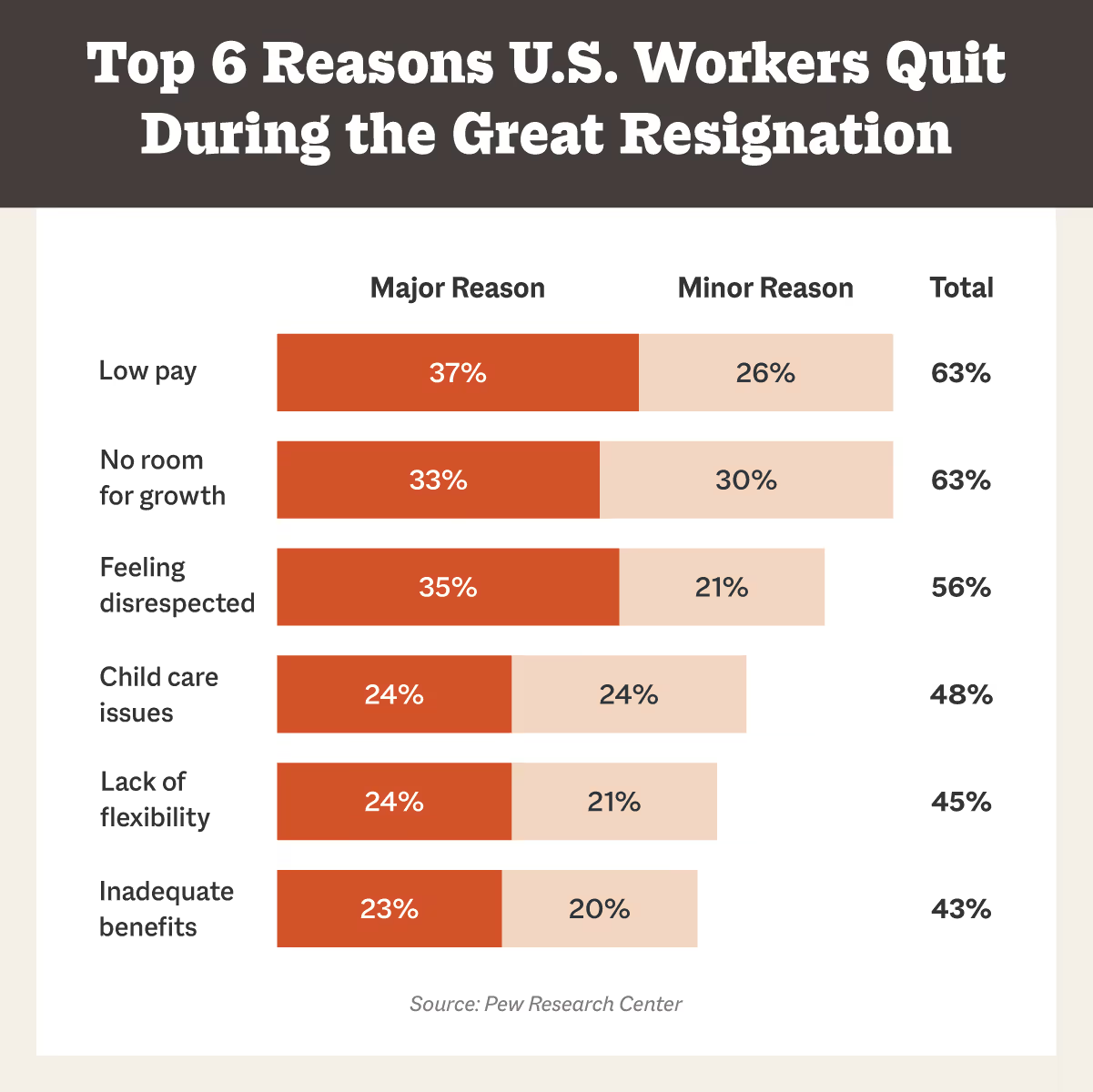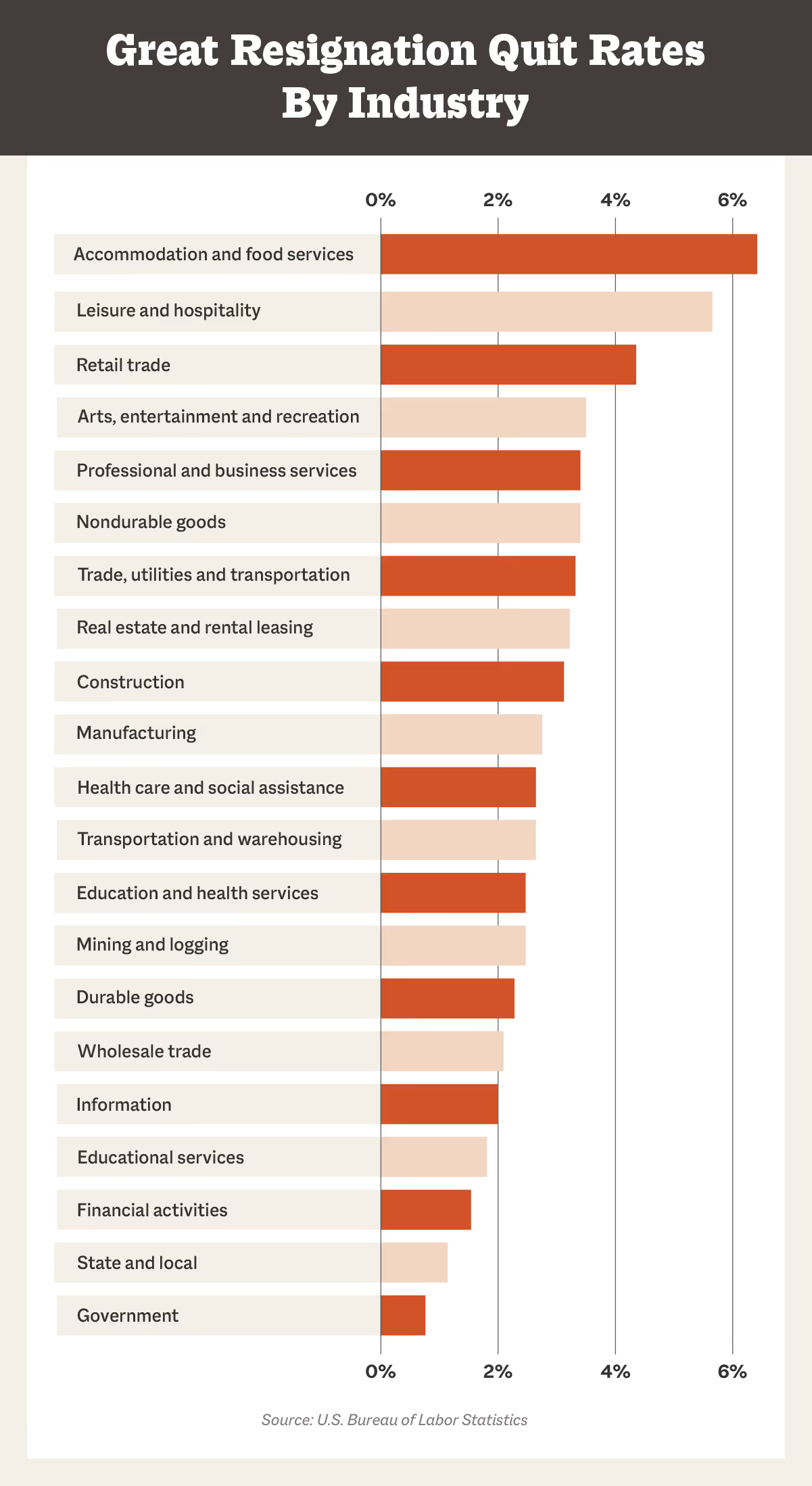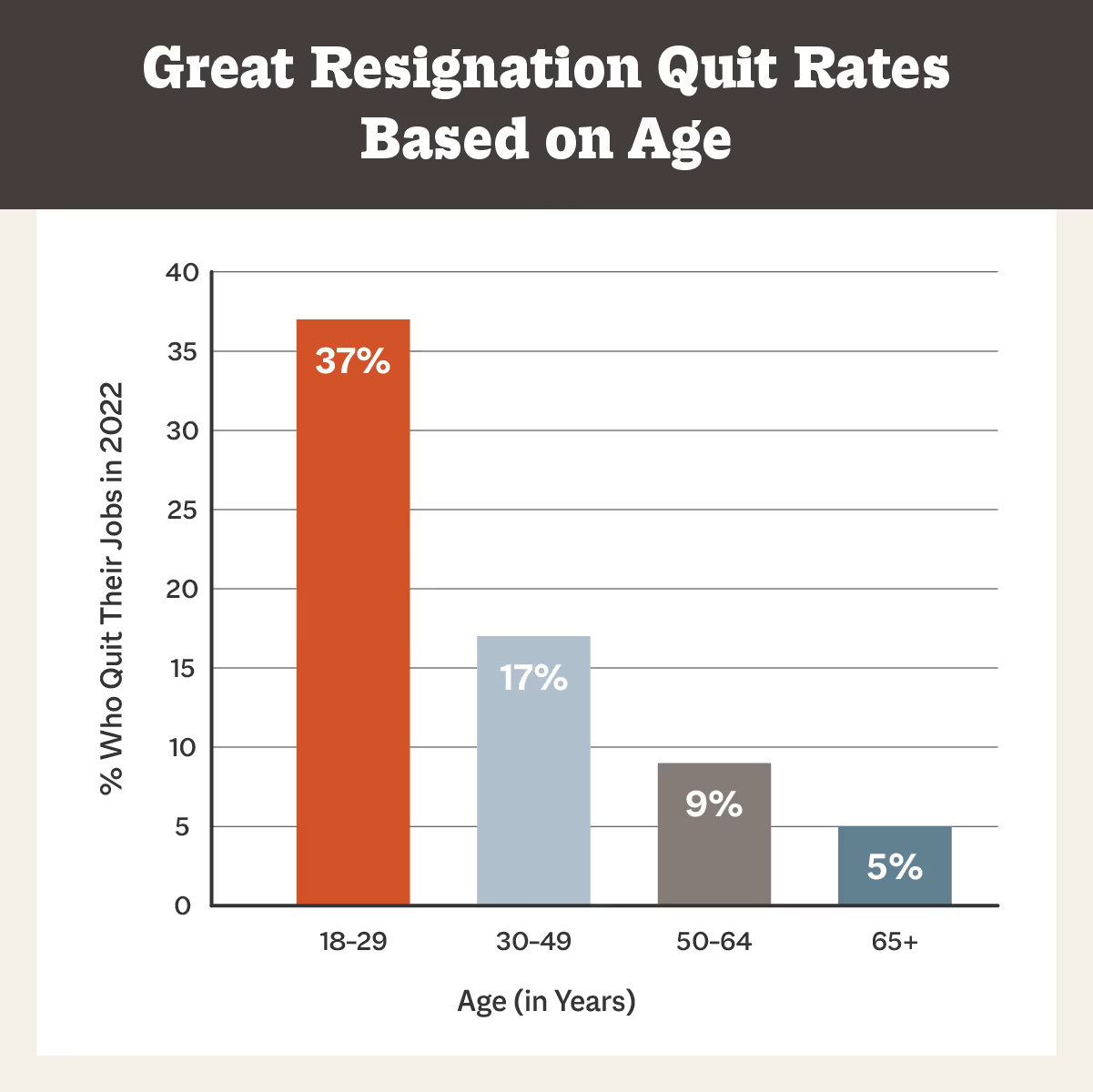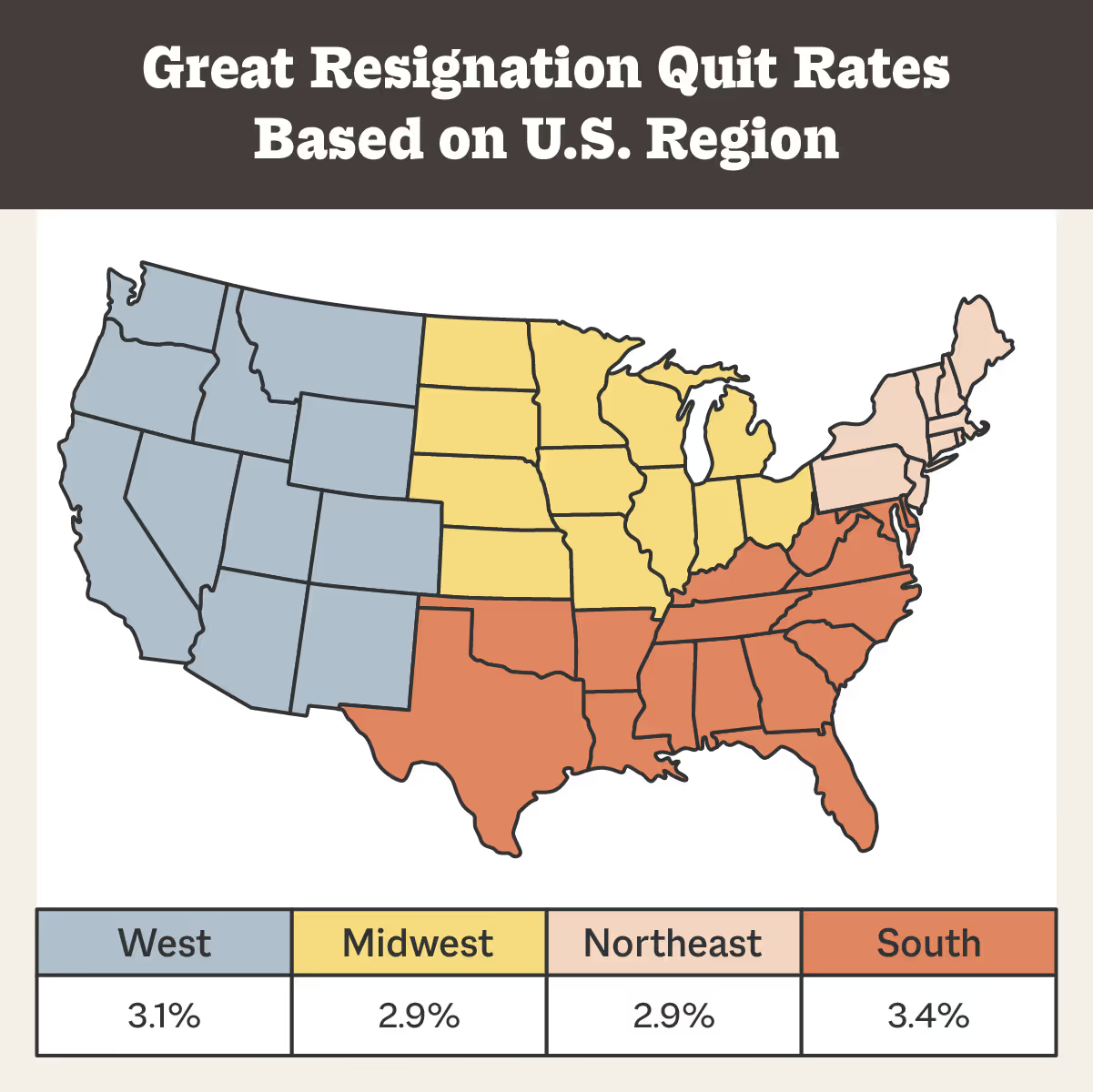Great Resignation Statistics & How To Offset Losses With Outsourcing
Great Resignation Statistics & How To Offset Losses With Outsourcing

You’re not alone if a team member or even several have recently left your company. Since the spring of 2021, millions of people have made the decision to quit their jobs, which has led to the “Great Resignation” we're currently seeing. A record-breaking 4.53 million people quit their jobs in March 2022 alone.
With strong labor demands and low unemployment rates, this pattern has had a tremendous impact on both businesses and employees across the nation.
By understanding what factors are most responsible for your employee turnover, you can make the necessary adjustments to increase employee retention rates and minimize how your business is impacted by the Great Resignation.
Continue reading to learn interesting Great Resignation statistics as well as some reasons for hiring outsourced help and how your business can benefit.

What is the Great Resignation?
The term "Great Resignation" refers to the rapid rate at which U.S. workers have quit their jobs since the spring of 2021.
According to the U.S. Bureau of Labor Statistics:
- An average of 3.98 million Americans quit their jobs each month in 2021.
- The U.S. saw a record-breaking quit rate when 4.51 million Americans left their jobs in November 2021.
- By the end of 2021, over 47 million Americans quit their jobs.
- In March 2022, a new record was broken with 4.53 million Americans quitting their jobs.
Why is the Great Resignation happening?
The Great Resignation's origins can be traced back to March 2020, when the pandemic brought about a virtually unprecedented turmoil in the American labor market. During this time, people reevaluated many aspects of their lives, including what they truly valued out of their employment.
Employees don't typically leave their jobs without good reason. After all, people depend on their employment for paying their bills, having health insurance, and building their savings for retirement.
Below you’ll find the top reasons why Americans resigned from their jobs, according to a Pew Research Center survey, along with possible explanations.

Low pay
63% of U.S. workers list low pay as a reason they quit their job.
Low compensation was one of the most common reasons given by Americans for leaving their jobs, with 37% ranking it as a major cause and 26% as a minor one.
Given that pay is one of the main causes of resignation, it's important that companies don't treat workers as expendable. Instead, they are an asset to their business. If workers feel appreciated by their employer, they will be considerably more vested in both their work and the business they work for.
Greater compensation is one approach to convey value to employees. By investing in a larger wage for workers, business leaders can also expect more productivity and better quality of work.
No opportunities for advancement
63% of Americans list a lack of opportunities for advancement as a reason they quit their job.
Lack of opportunities for promotion inside the organization was another common reason for people to leave their positions, with 33% of employees citing it as a major factor and 30% as a minor reason.
In fact, research on employee training reveals that 76% of workers look for chances to advance their careers. Employees may feel underprepared or stuck in their current position if the organization doesn't provide them with the appropriate training or possibilities for advancement.
Employees view training and development initiatives as investments in them. Maintain ambitious, high-performing, and growth-seeking employees by demonstrating to them that their development matters.
Feeling disrespected at work
56% of U.S. employees quit their jobs due to feeling disrespected at work.
More than half of employees surveyed said that they left their employment because they felt disrespected at work, with 35% saying it was a major reason and 21% saying it was a minor one.
Employees will feel disrespected if they feel that their superiors or peers don't appreciate them. In fact, 62% of workers believe their jobs have impacted their mental health, and 12.3% of workers say their manager doesn't value their work-life balance.
As an employer or team leader, it’s important to make sure your team members feel valued for their efforts and are recognized for their successes. You should also respect their time outside of work and give them opportunities to take time off to recharge if needed.
Child care issues
48% of Americans left their jobs because of child care issues.
About half of workers with children under the age of 18 mentioned child care issues as a reason for leaving their jobs, with 24% citing it as a major and another 24% as a minor reason.
Inconsistencies in child care arrangements are the leading cause of stress and unscheduled absences from work for employees with young children, according to a new Bright Horizons study. In fact, 62% of working parents claim that their capacity to work depends on the continuity of in-person child care or schooling.
Child care is an important concern for employees and should play a significant role in a company's entire recruitment and retention strategy. This could take the form of supplying after-school and summer camp assistance, offering subsidies to make childcare more affordable, or even providing backup childcare.
Lack of flexibility
45% of U.S. workers left their job because it didn’t offer enough flexibility.
Lack of flexibility, such as not being able to choose their own hours, was cited by 24% of Americans as a major cause for leaving their work and 21% as a minor one.
While the pandemic disrupted the entire workforce and forced employers to adopt a virtual workplace, many employees found value in the flexibility that came with remote work. In fact, 84% of employees shared that working remotely after the pandemic would make them happier.
Some businesses that weren’t fully virtual, however, rejected this new shift and insisted that their workers return to the workplace as soon as the pandemic's limitations were lifted. As a result, employees felt they were being micromanaged and were not being heard.
If you are able to, consider adopting a hybrid work model so that your employees can have more flexibility and work-life balance.
Inadequate employee benefits
43% of Americans cite that the reason they quit their job was because their company didn’t offer good enough benefits.
Another factor contributing to U.S. workers leaving their jobs was the absence of desirable benefits like health insurance or paid time off; 23% of respondents cited this as a major factor and 20% as a minor one.
Forty-six percent of people who quit their jobs and found new ones said the benefits at their new employment were superior to those at their old one. Considering the fact that 51% of employees view benefits as an extremely important factor for retaining talent, employers must provide appealing benefits in addition to fair compensation to retain top talent and lower employee turnover.
Great Resignation statistics by industry
Many industries have been impacted by the Great Resignation in different ways. Some industries may have experienced millions of workers quitting, while another industry may not have felt much of an impact.
Thanks to the Bureau of Labor Statistics’ Economic News Release, we broke down the top quit rates per industry throughout the year so you can see the effect the Great Resignation has had on each industry.

Highest quit rates by industry
Below is a list of the highest quit rates for each industry since the Great Resignation:
- Accommodation and food services: 6.1%
- Leisure and hospitality: 5.7%
- Retail trade: 4.6%
- Arts, entertainment, and recreation: 3.7%
- Nondurable goods: 3.6%
- Trade, transportation, and utilities: 3.6%
- Professional and business services: 3.5%
Moderate quit rates by industry
Below is a list of the second highest quit rates for each industry since the Great Resignation:
- Real estate and rental and leasing: 3.4%
- Construction: 3.3%
- Manufacturing: 2.9%
- Health care and social assistance: 2.8%
- Transportation, warehousing, and utilities: 2.8%
- Education and health services: 2.6%
- Mining and logging: 2.6%
Lowest quit rates by industry
Below is a list of the lowest quit rates for each industry since the Great Resignation:
- Durable goods: 2.4%
- Financial activities: 2.2%
- Wholesale trade: 2.1%
- Information: 1.9%
- Educational services: 1.7%
- State and local government: 1.2%
- Federal government: 0.8%
Great Resignation statistics by demographic
The United States is a very diverse nation with people of all ages, nationalities, and other backgrounds. In light of this, check out some of these Great Resignation statistics based on U.S. demographics.
Age
Adults under 30 years old had a far higher likelihood of having quit their job voluntarily in 2021 than older adults. Below you’ll find a breakdown of different age groups who quit their jobs throughout 2021 and 2022:
- Ages 18-29: 37%
- Ages 30-49: 17%
- Ages 50-64: 9%
- Ages 65 and older: 5%

Education level
Based on the Pew Research Center study, postgraduate degree holders were the least likely to report quitting their jobs in 2021, showing that employees are less likely to leave their work the more education they have. Here’s a further breakdown of quit rates based on education level:
- High school diploma or less: 22%
- Some college: 20%
- Bachelor’s degree: 17%
- Postgraduate degree: 13%
Region
Over the past year, there have been varying numbers of resignations in various U.S. regions. The majority of quitting occurred in the Southern states, while the Northeastern states had the lowest rate. Here is a closer look at U.S. region-based quit rates:
- South: 3.4%
- West: 3.1%
- Midwest: 2.9%
- Northeast: 2.2%

Income status
Those with lower incomes are more likely to quit their jobs. In fact, compared to employees with higher wages, individuals with lower incomes were twice as likely to leave their positions.
Given that the most common reason for wanting to leave a job was not being paid enough, this gap may not be surprising. The quit rates according to income level are further broken down as follows:
Lower income: 24%
Middle income: 18%
Upper income: 11%
5 Reasons outsourcing can help with employee losses
You might be wondering whether there are any potential options to offset support for your business now that you are aware of the effects the Great Resignation has had on the country, and may still have, by the looks of current trends.
With business services among the highest quit rates, B2B outsourcing is a great solution. If your business is experiencing high turnover rates, check out these main reasons why you should outsource help now.
1. Save money
Think about the $65,420 average annual salary of sales representatives. You're looking at far more than that once you factor in benefits, commissions, and bonuses.
If you currently handle all of the sales for your company, you can be losing money by missing calls from potential customers or wasting precious billable time.
Because outsourcing sales doesn't entail outsourcing the entire process, you can focus your outsourcing efforts where you'll get the best return on your investment.
2. Improve profitability
Speaking of ROI, outsourcing can assist in increasing your profit margins. This is because qualified personnel, like our 24/7 virtual receptionists, can capture and qualify leads, book new clients, and build better relationships with your existing ones — all without increasing overhead costs from staff on payroll.
Virtual receptionists have the skills to do various tasks efficiently and effectively so they can take the weight off your in-house teams’ shoulders. By outsourcing help, you can increase sales conversions on calls while staff members remain focused on customer work that can’t be outsourced (think: a HVAC technician installing new A/C!).
3. Easily scale your sales
Internal sales teams may be accustomed to a particular method of operation, so implementing a new system or procedure takes time and resources. Because an outsourced team is well trained, these transitions occur quickly and with little inconvenience.
As a bonus, you won't be in charge of recruiting, educating, monitoring, or managing new sales reps, allowing you to focus your attention elsewhere. With monthly plans instead of annual salaries, you’ll also have more control to simply expand or contract based on customer demand, keeping costs better in line with revenue.
4. Improve customer experience
Customer satisfaction is essential for business growth. It goes without saying that top-notch customer experience increases brand loyalty.
As soon as a potential buyer picks up the phone, their opinion of your customer service is established. They form an immediate first impression of you based on how quickly you answer the phone, your voice’s tone, and the caliber of your responses. They anticipate the same (or higher) level of service when they follow up via phone, live chat, or email.
Working with an outsourced team streamlines the sales process and guarantees there is always someone ready to provide assistance and answer concerns, which improves the omnichannel customer experience.
5. Focus on your business
When your time isn’t taken up by answering calls and booking appointments, you can focus more on your business and its needs. Fewer interruptions will improve the quality of your and your employees’ job, and you'll be able to expand your billable hours and take on additional clients. You'll also be able to concentrate on the larger-scale aspects of sales, such as market analysis and trend data.
Consider outsourcing to Smith.ai virtual receptionists
As you can tell, the Great Resignation has had a major impact on businesses throughout the United States, but we are here to help.
Smith.ai offers high-quality and dependable outsourcing solutions for any business, regardless of its industry, size, budget, or goals. Through efficient outreach campaigns, first-rate virtual receptionist services, and unmatched live chat services, we know how to communicate efficiently with leads to increase revenue.
Book a consultation to learn more about how we can help your business flourish, even in difficult economic times.
Sources: U.S. Bureau of Labor Statistics 1, 2, 3 | Pew Research Center | Leftronic | Self | Bright Horizons | TeamStage |
Take the faster path to growth. Get Smith.ai today.
Key Areas to Explore
Technical Implementation Terms
Voice user interface (VUl) design
Speech recognition integration
Text-to-speech optimization
API connectivity and webhooks
Real-time data synchronization

Your submission has been received!














.svg)



